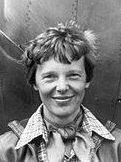solo flight
 As airplanes became an accepted form of transportation, people began to consider traveling further and further. Of course, those first airplanes could never have made the flight across the ocean, but these days planes fly that far with ease. Still, someone had to be brave enough to take that first flight across the ocean. Someone had to trust their plane enough to make the attempt. British aviators John Alcock and Arthur Brown decided to be the first to make that leap when they made the first non-stop transatlantic flight in June 1919. Their plane was a modified First World War Vickers Vimy bomber. They flew from Saint John’s, Newfoundland to Clifden, Connemara, County Galway, Ireland. Like most accomplishments, the competition was fierce, and there had to be a reward for the winner. The Secretary of State for Air, Winston Churchill, presented them with the Daily Mail prize for the first crossing of the Atlantic Ocean by airplane in “less than 72 consecutive hours”. A small amount of mail was carried on the flight, making it the first transatlantic airmail flight. The two aviators were awarded the honour of Knight Commander of the Most Excellent Order of the British Empire a week later by King George V at Windsor Castle.
As airplanes became an accepted form of transportation, people began to consider traveling further and further. Of course, those first airplanes could never have made the flight across the ocean, but these days planes fly that far with ease. Still, someone had to be brave enough to take that first flight across the ocean. Someone had to trust their plane enough to make the attempt. British aviators John Alcock and Arthur Brown decided to be the first to make that leap when they made the first non-stop transatlantic flight in June 1919. Their plane was a modified First World War Vickers Vimy bomber. They flew from Saint John’s, Newfoundland to Clifden, Connemara, County Galway, Ireland. Like most accomplishments, the competition was fierce, and there had to be a reward for the winner. The Secretary of State for Air, Winston Churchill, presented them with the Daily Mail prize for the first crossing of the Atlantic Ocean by airplane in “less than 72 consecutive hours”. A small amount of mail was carried on the flight, making it the first transatlantic airmail flight. The two aviators were awarded the honour of Knight Commander of the Most Excellent Order of the British Empire a week later by King George V at Windsor Castle.
As with any record, there is always room for improvement. The first flight took place with two people on board, so on Ma 21, 1927, at age 25, Charles Lindbergh went from being an unknown United States Air Mail pilot, to world fame instantly, by making his Orteig Prize winning nonstop flight from Long Island, New York to Paris. He covered the 33½ hour, 3,600 miles alone in a single-engine Ryan monoplane called the Spirit of Saint Louis.  The plane was build for this flight. This was the first solo transatlantic flight, and the first non-stop flight between North America and mainland Europe. I wonder what he was thinking as he flew for 33½ hours alone over the ocean. He had to keep himself awake, and on course. There was no one else to do it. Most of us have a hard time staying awake for more than 17 or 18 hours, much less 33½ hours. It was an amazing feat, and one for which the fame he gained was well deserved.
The plane was build for this flight. This was the first solo transatlantic flight, and the first non-stop flight between North America and mainland Europe. I wonder what he was thinking as he flew for 33½ hours alone over the ocean. He had to keep himself awake, and on course. There was no one else to do it. Most of us have a hard time staying awake for more than 17 or 18 hours, much less 33½ hours. It was an amazing feat, and one for which the fame he gained was well deserved.
As with any record, someone had to beat it or improve on it or change it in some way. The record held until May 21, 1932, when Amelia Earhart became the first woman to make a solo air crossing of the Atlantic Ocean, from Newfoundland to Ireland. As with Charles Lindbergh, I wondered how Amelia stayed awake for all those hours, and what she was thinking as she flew along…alone for all those hours. I’m sure there was excitement in the extreme, but I’m sure she was weary after the flight was over too.

